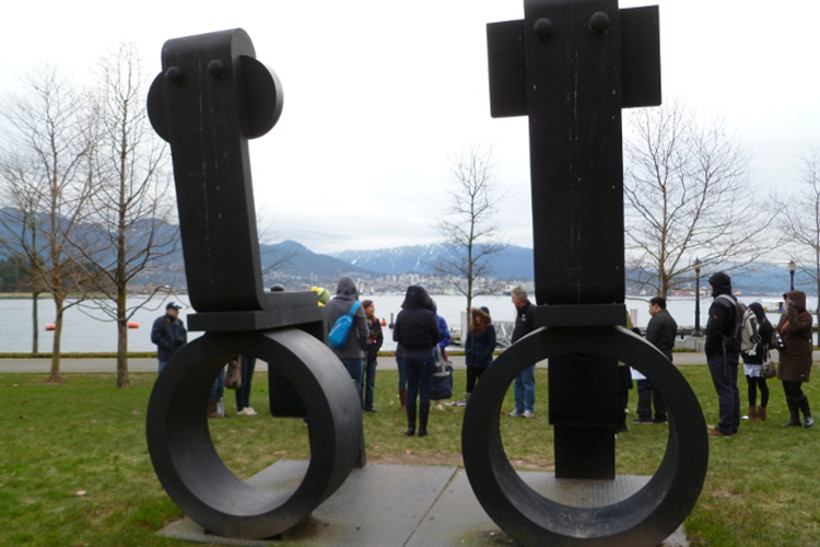King and Queen
Arts Education, Language Arts, Planning, Social Studies
Sculpture Title:
King and Queen
Learning Lens:
Approaches to Learning; Community and Service
Curriculum Access:
Social Justice, Social Studies, ESL, Career and Personal Planning, Drama, English, Applied Skills
BIG IDEA:
Evaluating how industrialization has shaped the relationship between human and machine.
Guiding Question:
How does the machine and industrialization shape society?
Strategies:
Mindfulness practice, Socratic questioning, team building, experiential learning, informal assessment, critical thinking, prompting
Background for Students:
Romanian born, Canadian artist Sorel Etrog is one of Canada’s preeminent artists, sculptors, painters, illustrators, poets and filmmakers. Born in 1933 his career has spanned over 40 years. His work is currently displayed around the world in prestigious galleries and private collections. In King and Queen, Etrog explores the relationship between man and machine. There is also the pronounced power and position inherent in the sculptures and their placement. Etrog has developed a complex visual vocabulary to create an art that explores the tension of our times. Etrog describes his art as “tension created by pulling together and pulling apart, with being stuck and being freed, a world of grabbing and holding on and losing hold… bringing shapes together but at the same time giving each an independence.” In this tension exists the exploration of power and position and the exploration of machine and society.
Informal Assessment:
Through discussion, ensure students form an expanded meaning of the invasive nature of things/stuff as it shapes our daily lives. Through discussion and Socratic questioning guide the students through a brainstorming exercise.
Materials:
Pen and paper
Curricular Challenge:
15-20 minutes, Open/Reflect: Welcoming Multiple Interpretations
1. Students are encouraged to disengage from their recent experience and their busy surroundings to practice mindfulness.
2. Direct students to ‘mindfully’ (quietly/individually) explore the piece and develop their own interpretation.
*More information on mindfulness for the classroom can be found here.
3. Direct each student to share their interpretation of the piece without judgement.
4. Connect students’ individual interpretations to the background information provided above.
60 + 45 minutes Challenge
In science fiction (Frankenstein to Toy Story), machines are often brought to life. In exploring the relationship played out between machines and humans it can be useful to look at the thoughts that machines may have in their battle for a better life. Have students pick a machine that is important to them or was important to them. They can make a few quick notes on why they value the particular machine and then look at what will eventually influence them to lose that value (10 – 15 minutes).
In the machine world, a loss of value leads to extinction. The machine mind will be in constant fear that it will be devalued. In groups of four, compare these thoughts to the human thoughts that place the value on the machine. For example: Human mind: I need this (iPhone, tablet, car…) to be accepted, be part of the group, be able to survive vs the machine mind that is worried that the next incarnation (new colours, smaller and more powerful, faster…) will leave them as devalued junk. Have the group write a short comedy sketch on the interplay of human mind and machine mind that can be performed for the class.
Discussion: Through discussion and Socratic questioning, ensure students have considered the following: how is value placed on machine/on self? are external objects reflections of the person or is the person a reflection of the object? does the machine shape the need or does the machine fill an existing need? Have the students consider real life examples for these questions.
Follow-up: In each Challenge there is a balance that needs to be struck; but, before this balance can be established, an in-depth, clear and unbiased investigation must take place. In groups or as a class, using mindfulness techniques, dichotomies, and values clarifications, have students work out the basis of their personal value/self worth. How can a developed awareness of self worth lead to change in the community/in the world? The guiding question is: Is self worth and personal value established internally or externally? With the assistance of a counsellor, allow students the freedom to evaluate race, sexual orientation, religion, body image, wealth… The challenge is: How can I bring a mindful attitude of self worth to the world? How will a mindful attitude of self worth change the world?
